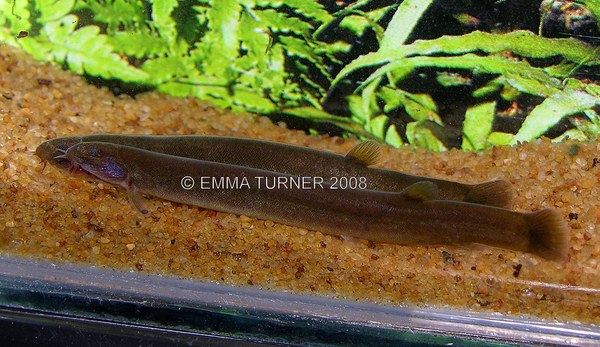Pangio pangia
Summary
Scientific name: Pangio pangia (Hamilton,1822)
Common name: Cinnamon Loach, Cinnamon Kuhli Loach
Synonyms: Cobitis pangia, Cobitis cinnamomea, Acanthophthalmus pangia, Canthophrys rubiginosus, Pangia cinnamomea.

Distribution: India, Bangladesh, Myanmar
Sexual Dimorphism: Females probably noticeably plumper when loaded with eggs as seen with other Pangio species.
Maximum size: 6cm (2.5 inches)
Similar to: Pangio oblonga, Pangio filinaris, Pangio mariarum.

Care: All kuhli loaches require mature aquaria and should not be considered for newly set up tanks. A soft sandy substrate should be provided with lots of shady hiding places amongst bogwood and plants. As with other species of kuhli loach, these fish are best maintained in groups of three or more. However, given the rarity of this particular species and the fact they have only shown up sporadically (or in other fish shipments as 'contaminants'), it may not be easy to source that many specimens. In such cases, it would be wise to provide them with company of similar species, such as P. oblonga.
Feeding: Sinking catfish pellets/granules, flake/crisps, small frozen foods such as mosquito larvae, daphnia, brineshrimp, baby brineshrimp, cyclops etc.
Water parameters: pH: 6.0-7.0, Hardness: Soft, Max dH: 12.
Temperature: 24-26 deg C (75-79 deg F)
Breeding: There are currently no reports of this species breeding in the home aquarium.

Description: Dorsal soft rays (total): 10 - 10; Anal soft rays : 9; Vertebrae : 47 – 52. Differs from the other members of the P. oblonga group by the following characters: from P. filinaris and P. mariarum by the absence of the nasal barbel (vs presence) and from P. oblonga by a narrower body (7.6-9 times SL vs 7.2-7.7).

Notes
All specimens shown on this page (photographed by Emma Turner) originated from India.
Photo Gallery
Click to view all images of this species! |
Document Actions


